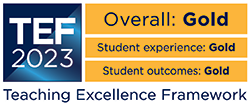Teesside is a top performer for widening participation
Teesside is once again one of the top performing universities in the country in terms of opening its doors to less well-off students for the fourth year running.
The welcome news, confirmed today (18 December, 2002) in the Higher Education Funding Council for England Performance Indicators for under-represented groups in higher education, supports Teesside’s mission to be the Opportunity University.
The Performance Indicators were introduced four years ago by the Funding Council to monitor the make-up of the higher education student population, with benchmarks set for each university based on courses offered and the current student mix.
The latest figures published today (18 December, 2002) show that the University of Teesside exceeded its target benchmarks, with the number of young full-time first degree entrants as follows:
From state schools at Teesside - 98% (compared to a benchmark of 93%)
From working class backgrounds - 38% (compared with a benchmark of 32%)
From low participation neighbourhoods - 22% (benchmark of 15%).
The percentage of mature full-time entrants across all undergraduate courses was up by one percentage to 38%. A total of 25% of the University's mature students had no previous experience of Higher Education (HE) and came from a neighbourhood with low participation in HE, compared with a benchmark of 15%.
This year there are figures for the first time for participation by disabled students. Teesside has 2.4% disabled students on full-time courses compared with a benchmark of 1.6% and 1.6% part-time disabled students compared with a benchmark of 0.4%.
The figure for non-continuation following year of entry for young first degree students was 11%, compared with a benchmark of 12%, and for all entrants 12%, compared with a benchmark of 13%.
Professor Graham Henderson, the University’s Vice-Chancellor designate, said: “We are very pleased that Teesside has exceeded its benchmarks for attracting under-represented entrants. These include the figures set for mature full-time students and entrants from state schools and from Social Classes 3, 4 & 5 as well as for students from neighbourhoods with lower-than-average participation rates in higher education.
“The data is a very useful indicator and shows that we are playing a major role in widening participation and providing opportunities for a wider range of people than many of the traditional universities."
 Supporting Nigerian farmers by transforming food waste into
...
Supporting Nigerian farmers by transforming food waste into
... International partnership signed with prestigious American
...
International partnership signed with prestigious American
... Teesside University academics join prestigious network of
...
Teesside University academics join prestigious network of
...